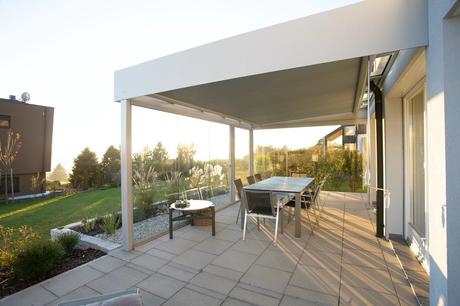
Image Source - CC0 Licence
A garden patio is a fine investment that breathes life into your outdoor area. If you’re looking for ways to make the most out of a family garden, this is one of the best additions. In the blink of an eye you’ve got some outdoor living space; a place to have dinner, relax in the sun or host evening parties with friends.
You could opt for wooden decking here, but the patio is probably a tad better. For one, it’s more versatile and you can find loads of different designs. Secondly, it adds a classier look to your garden. And thirdly, it’s much easier for you to maintain and will last for much longer.
When your patio is installed and ready to use, you will need to look after it. As just mentioned, patio maintenance isn’t too complex and you don’t need to do many things that regularly. There is just one thing you should focus on to keep your patio in the best possible condition: the weather.
That’s right, patios are susceptible to the elements and can become damaged when left exposed all the time. Mainly, your biggest worries are UV rays from the sun, rain and cold weather. The happy news is that you can protect your patio from different weather conditions - and it’s not overly challenging. If you keep on reading, you’ll find a guide explaining precisely what to do!
How To Protect A Patio From Sun Damage
The sun will damage just about anything and everything. If you lie in the sun for too long, your skin gets burnt. If your furniture is exposed to the sun for too long, it starts to fade in color.
Likewise, your patio will be affected by constant sun exposure - especially when it’s very bright and hot. Two main problems are likely to exist:
Fading
Tile cracking
Fading happens because the UV rays fade the natural color of your tiles and can make them look really old and worn. Likewise, cracking happens when tiles are exposed to the sun and get extremely hot, meaning they expand and can start cracking. If your patio is exposed to the sun for hours a day, it won’t be long before you start seeing both of these issues - particularly during heat waves, which are increasingly common.
Thankfully, it’s really not hard to protect a patio from sun damage. You should start by sealing your patio pavers to provide an extra layer of protection. Patio sealant forms a barrier over your pavers, so they don’t receive direct contact from UV rays. It’s a bit like walking around permanently covered in SPF! There are other benefits to doing this as well, such as reducing weed growth and improving the general durability of the patio tiles.
The second idea is even simpler; keep your patio covered!
You can do this in a plethora of ways, such as erecting a pergola around the patio or using large sun umbrellas. If you’d rather shade your patio permanently, then it makes more sense to build a patio cover with a proper roof. Nowadays, modern corrugated sheet material is the best for outdoor structures like this as it provides protection from both the sun and the rain.
It’s completely up to you how you cover your patio, the important thing is that you do it somehow. Pick a method that suits both your needs and the aesthetic of your home. Combined with sealant, this gives you all the protection you need from the baking sun. Your patio should now last for much longer and maintain its original appearance for years. You will no longer have to worry when it gets super hot as you know your patio can withstand the elements.
 Image Source - CC0 Licence
Image Source - CC0 LicenceHow To Protect Your Patio From Rain
Did you know that one of the main reasons people opt for a patio over wood decking is its performance in rainy conditions? When wood is constantly exposed to rain, it can start to expand and split. Even worse, regular wet weather may lead to the wood rotting, causing all sorts of problems in your decking.
On the other hand, patio pavers stand up to wet weather more effectively and there’s never the risk of rotting. Still, lots of heavy rain can cause issues for a patio. It depends on the materials used during construction, but many patios are laid using natural stone. This looks gorgeous but has the drawback of being very porous. Therefore, rain can be absorbed into the stones, causing them to swell up. This leads to - yep, you guessed it - cracks in the tiles over time.
Another danger brought about by wet weather is standing water. Puddles appear on your patio and can create slip hazards if someone pops outside. They may also hang around for a long time, so even when the rain stops, it’s hard to use your patio because there are big puddles everywhere.
Luckily, there are ways to protect a patio from the rain - starting with the installation. As much as you may love DIY, always ensure your patio is installed by a professional. Why? Because they will install it so it drains properly. This will include a natural drainage system to prevent standing water as well as fitting the patio so water falls off to the sides rather than staying on top.
Alongside this, you will need to do the same two things spoken about before. Sealing your patio adds a layer of protection from the rain as it stops the pavers from absorbing water. It’s recommended that you should seal your patio every 3-5 years. If you get a lot of rain, you might want to increase the frequency to every 1-2 years. It’s probably best to consult with an expert here as they can look at your patio and determine how often sealant is needed.
Of course, protecting your patio with some sort of covering will keep a lot of the rain away. You need a roof or awning that completely covers the patio and blocks a lot of the rain. Pergolas are also really good here as you can build ones with more protection around the sides too. Either way, if your patio is covered, the rain can’t get on it!
How To Protect Your Patio From Cold Weather
As winter rapidly approaches at an astounding rate of knots, your attention will turn to cold weather protection. Looking at pavements and roads during the winter will show you all you need to know about the impact of cold weather on stone tiles/pavers.
For the most part, your biggest concern is your patio cracking. This can happen due to a couple of factors:
When moisture lands on your patio in the winter, the cold air can freeze it. Water expands as it freezes, which can lead to pavers breaking or cracking.
Cold temperatures reduce the strength of stone patios or tiles and make them more brittle. As a result, there’s a much higher risk of chips or cracks when you walk on the surfaces.
Keeping both of these things in mind, we need to tackle two main issues:
Moisture
Cold temperatures
As we’ve already mentioned a few times, you can protect your patio from moisture by using covers. In the winter, you could go one extra mile and completely cover your patio in tarpaulin or some type of canvas. Think about it, you’re unlikely to be outside during the cold months, so nobody will use the patio anyway. If you can remove the furniture and put it in your garage, then you can easily lay down some tarpaulin and secure it in place with heavy stones or weights. Otherwise, get furniture covers for your outdoor furniture as well.
Having a cover like this may also address the cold issue as it provides insulation for your patio. Or, another idea is to have patio heaters. Turn them on now and then to heat up the patio area and prevent the cold weather from freezing the pavers. As a side note, if you do fancy going out on your patio during winter, some heaters make it a more comfortable experience for everyone!
Of all the weather issues, cold temperatures are the worst thing for your patio. Make sure you have something in place to protect the patio from rain or snow while also maintaining a better temperature.
After looking at that, we’ve reached the end of this guide! There’s a big chunk of information to take in, but it’s actually far simpler than you think. If we break everything down, we can say all you need to do to protect your patio from the elements is as follows:
Have some type of cover in place to block UV rays and protect from rain/snow
Seal your patio every couple of years for added durability and protection from UV rays and rain
Install the patio properly to improve the drainage and prevent standing water
Get patio heaters during the winter to stop freezing
Realistically, it’s not that hard and you will have a stunning patio all-year-around that lasts for decades.

